There is no single Jungian interpretation of the Ace of Cups. That it represents a major archetypal motif is without question for it suggests the feminine, mother, breast, womb, water, vessels, and related ideas of love, emotion, nourishment, healing, sacrifice, rebirth and renewal, the unconscious, imagination, empathy, psychic awareness and more. The value of a Jungian approach is that it encourages a Tarot reader to be aware of the multi-dimensional wealth of meaning in the cards, while allowing them to guide, honor and support a querent’s own wisdom and self-knowledge. You may want to read my other two posts on the Ace of Cups first. Part 1. Part 2.
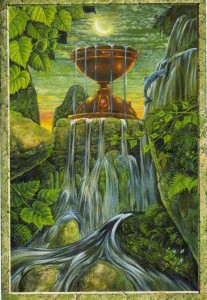
Druidcraft Tarot
First we have to ask: what is a Jungian approach to a symbol? Is it simply pointing out all the symbolic interpretations (see my earlier posts on the Ace of Cups) and mythological and cultural referents? From this point of view, I could begin with several quotes from Jung on the image of the cup and Grail:
The bowl is a vessel that receives or contains, and is therefore female. It is a symbol of the body which contains the anima, the breath and liquid of life. CW18. p 121.
Vessel symbolism probably contains a pagan relic which proved adaptable to Christianity, . . . which secured for the Christian Church [in Mary] the heritage of the Magna Mater, Isis, and other mother goddesses. CW6 ¶ 398.
The aesthetic form of the symbol must appeal so convincingly to our feelings that no argument can be raised against it. For a certain time the Grail symbol clearly fulfilled these requirements, and to this fact it owed its vitality. CW6 ¶ 401.
The symbolism of the vessel has pagan roots in the “magic cauldron” of Celtic mythology. Dagda, one of the benevolent gods of ancient Ireland, possesses such a cauldron, which supplies everybody with food according to his needs or merits. CW6 ¶ 401.
The Hermetic vessel, too, is a uterus of spiritual renewal or rebirth. This idea corresponds exactly to the text of the benedictio fontis [“blessed font”]. . . . We could take this water as the divine water of the [alchemical] art, since after the prima materia this is the real arcanum. . . . The water, or water of the Nile, had a special significance in ancient Egypt. . . A text from Edfu says: “I bring you the vessels . . . that you may drink of them; I refresh your heart that you may be satisfied.” CW13 ¶ 97.
“The healing cup is not unconnected with the “cup of salvation,” the Eucharistic Chalice, and with the vessel used in divination: This is the divining-vessel of Joseph and Anacreon. . . . The content is the water that Jesus changed into wine, and the water is also represented by the Jordan, which signifies the Logos, thus bringing out the analogy with the Chalice. Its content gives life and healing.” CW12 ¶ 551.
The water chalice is associated with the baptismal font, where the inner man is renewed as well as the body. This interpretation comes very close to the baptismal krater of Poimandres and to the Hermetic basin filled with nous [“mind, intellect”]. Here the water signifies the pneuma, i.e., the spirit of prophecy, and also the doctrine which a man receives and passes on to others.” CW11 ¶ 313,
Jung also writes of the alchemical water that “purifies everything and contains within itself everything (i.e., for the process of self-transformation)” – Jung’s parentheses. He continues with something apropos the dove on the Ace, “You must know that the art of alchemy is a gift of the Holy Spirit” CW18, p. 799.
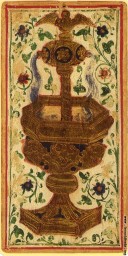
We can see from these many references, and the ones in my other posts on the Ace of Cups, that this is an archetypal image: an archaic remnant of instinctual patterns of meaning in the human psyche that influences our psychology. Gathering all the mythic and artistic examples of the motif is called amplification.
Amplification is seeing what is behind an archetypal image or symbol, enlarging it so as to view it from different perspectives, restoring it to its original fullness to discover what kind of forces could be working in it.
However, is amplification the main or even true Jungian approach to Tarot? In fact, symbol amplification has a certain seductiveness in that we think that by gathering more and more examples of a motif, we’ll discover its true meaning.
Perhaps we need to start somewhere else. And this is what Jungian dream interpretation and active imagination does. My book, 21 Ways to Read a Tarot Card, details several Jungian-based tarot techniques, which are impossible to include in a single blog post.
When discussing dream interpretation we find Jung giving advice in what has become my favorite quote:
“I have always said to my pupils: ‘Learn as much as you can about symbolism; then forget it all when you are analyzing a dream’,” CW18, p. 418. [Or a tarot reading!]
Jung elaborates on this elsewhere:
“True art is creation, and creation is beyond all theories. That is why I say to any beginner: learn your theories as well as you can, but put them aside when you touch the miracle of the living soul. Not theories but your creative individuality alone must decide,” CW17 ¶ 313.

Morgan-Greer Tarot
This, to my mind, is the best advice for a Tarot reader. Learn as much as you can about Tarot and its history and symbolism, then forget it all when you are doing a reading. Actually, I would say, set it to one side in a space in your mind that will hold your associations ready as they are needed. Instead, embrace yourself as creative artist. Focus your attention and energies on touching “the miracle of the living soul” before you, which means using your intuition to guide querents into their own experience of the image, for only the person can ascertain the meaning(s) for themselves.
This brings us back to the Ace of Cups for it is up to the reader to become the container, the holder of energies for the associations and emotions of the querent. In a process similar to that in dream interpretation, I advocate being a mid-wife of the soul, assisting the querent to engage with the images on the card and bring their own wisdom to birth. I encourage personal associations that well-up from the unconscious while keeping them tethered to the cards in the spread. When tears or other subtle signs appear, know that emotions are activated that yield personal meaning.
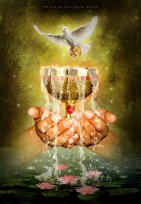
Georgina Gibson Ace of Cups
As tarot reader, I am also like the dove, bearing the cards in my beak, touching on the unconscious waters of the living soul. The lotus blossoms below are rooted in the deep mud, rising through the waters to bloom in the light of consciousness. They are the realizations that a querent takes home from a Jungian approach to a reading. What blossoms is a result both of the querent’s own conscious realizations and the greater patterns that point to that person’s own myth.
For Jung, meaning is a meeting of the soul “on its own ground, whenever we are confronted with the real and crushing problems of life” CW17, ¶ 81. Meaning is found in the creative confrontation with the opposites and the synthesis of the self into the scheme of creation—their personal myth (paraphrase from Memories, Dreams, Reflections, p. 338). And, from The Myth of Meaning in the Work of C.G. Jung by Aniela Jaffé, we find that meaning is “a human interpretation or conjecture, a confession or a belief . . . created by consciousness, and its formulation is a myth” [no page number]. To summarize: meaning is a myth formulated by humans to answer the unanswerable. Jung frequently notes that meaning is present in an emotional response to an image.
“A great work of art [such as Tarot] is like a dream; for all its apparent obviousness it does not explain itself and is always ambiguous. . . . It [art/dream/tarot] presents an image in much the same way as nature allows a plant to grow, and it is up to us to draw conclusions. . . . To grasp its meaning, we must allow it to to shape us [to act upon us] as it shaped him [the artist]” Jung, Modern Man in Search of a Soul, p. 175.
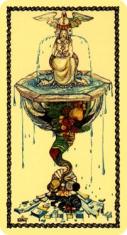
Medieval Scapini Tarot
To do this, we may use word association, active imagination, dialog, and other interactive methods favored by Jungians. We may also want to be aware of the interplay of the parts of the psyche that have been activated or the stage of the alchemical process of individuation. However, in contrast to Jungian psychoanalysis, we keep the light of awareness focused on and through the querent’s cards and question, to what they most need to hear at this time.
To be clear, there are times when you’ll want to amplify the images on a card: to compare the mythical and symbolic elements with a client’s circumstances. And, in some cases it is helpful to present querents with the archetypal aspects of their pattern and where it is headed as foreshadowed in associated myths. As Jung explained:
“This comparative work gives us a most valuable insight into the structure of the unconscious. You have to hand the necessary parallels to the patients too, not of course in such an elaborate way as you would present it in a scientific study, but as much as each individual needs in order to understand his archetypal images. For he can see their real meaning only when they are not just a queer subjective experience with no external connections, but a typical, ever-recurring expression of the objective facts and processes of the human psyche. By objectifying his impersonal images, and understanding their inherent ideas, the patient is able to work out all the values of his archetypal material. Then he can really see it, and the unconscious becomes understandable to him. Moreover, this work has a definite effect upon him. Whatever he has put into it works back on him and produces a change of attitude. CW18 ¶ 401.
Given the Jungian approach, there is no way I can tell you what meaning the Ace of Cups will have for an individual, as even for the individual it will vary over time. So, coming back to where I started with Marie Louise von Franz, I want to amplify just one aspect of this Ace of Cups image that may, at some point elucidate the soul’s work in a person. In The Psychological Meaning of Redemption Motifs in Fairytales, Marie-Louise von Franz writes:
“The Benedictio Fontis, baptism in the Church, represents the cleansing of the human being and his transformation into a new spiritual being. . . . On the Saturday before Easter the baptismal water is always blessed . . . by [the priest’s] making the sign of the cross over it. . . . It is said that the Holy Ghost will impregnate the water . . . so that out of this uterus of the divine font a new creature may be born,” p. 35.
Although any water may be used there is a special water used for Roman Catholic baptism called Easter Water. Traditionally it is blessed on the last Saturday of Lent, Holy Saturday, in a ritual where the paschal or Easter candle [an Ace of Wands!], representing Christ risen from the dead, is held in the water and the Holy Spirit is called upon, saying, “Wherever we may be, make the Holy Spirit present to us who now implore Thy mercy.”
Von Franz explains:
“The light of the candle would represent the light of an understanding attitude, an enlightenment of the mind which now enters the unconscious and fertilizes it . . . handing back conscious understanding and truth to the unconscious from whence it came so that it may be increased in power and effect. There is also the union of the opposites—fire and water—and the result is a fiery water. The baptismal water of the Church is often called aqua ignita since it is said to contain the fire of the Holy Ghost,” p. 35-36.
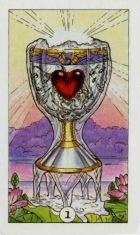
Robin-Wood Tarot
So, while the querent may wax long and lovingly on their hopes for a new relationship or the beginnings of some work of the imagination, as a reader, I will be looking to the other cards in the spread to see where and how there may be an influx of grace in which the unconscious is ignited, impregnated and fertilized in preparation for a healing and spiritual renewal. Or, like mystic and Golden Dawn member, Evelyn Underhill, said of the related cup of the Eucharist, it bodes a Divine Presence and a movement toward Love.
Finally, in a Jungian approach to Tarot, a reader would be aware, when the Ace of Cups appears that, of Jung’s four functions, the Feeling Function is actively involved in the gestation of a new awareness. Among other possibilities, it may signal that the querent’s currently activated mode of consciousness centers around what feels pleasant or unpleasant to them, and so the reader might aid in making them more conscious of this.
A Jungian approach to Tarot requires quite a bit of reading and study, first to understand the Jungian “map of the psyche” (self, ego, anima/animus, shadow, etc.) and other concepts like individuation, the four functions and so on, and then to become familiar with the archetypes expressed through myth and symbol. However, it may be a relief to recognize that most people will find that a modern study of tarot will have already introduced them to many of the concepts and methods discovered and made popular by Jung.

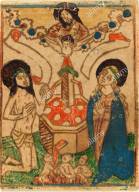
 Mary K. Greer has made tarot her life work. Check here for reports of goings-on in the world of tarot and cartomancy, articles on the history and practice of tarot, and materials on other cartomancy decks. Sorry, I no longer write reviews. Contact me
Mary K. Greer has made tarot her life work. Check here for reports of goings-on in the world of tarot and cartomancy, articles on the history and practice of tarot, and materials on other cartomancy decks. Sorry, I no longer write reviews. Contact me
6 comments
Comments feed for this article
February 6, 2018 at 12:54 pm
Ace of Cups Symbolism | Mary K. Greer's Tarot Blog
[…] Part 3: A Jungian Approach to the Ace of Cups […]
February 6, 2018 at 12:56 pm
Waite’s Eucharistic Ace of Cups | Mary K. Greer's Tarot Blog
[…] Part 3 is “A Jungian Approach to the Ace of Cups”. […]
February 6, 2018 at 1:00 pm
Donnalee
So many ways to approach this. Thanks Mary!
February 8, 2018 at 9:58 am
Jeri Lawson
Thank you, Mary. Your research and posts are illuminating on every level. Every time I reread this I am inspired in a different way.
April 14, 2018 at 8:57 am
gwynwas
Another amazing post!
This talk about what a Jungian approach reminds me of something I read by him (a long time ago). My recollection is that the shared archetype (and the associated analysis of cross cultural symbolism), is only the skeleton of meaning for any one individual. The flesh of the thing is the individual’s personal associations (derived from life experience, I suppose).
This is why, when I talk to people about dreams, I don’t attempt to analyze symbols in a vacuum. I always ask, what were you feeling in the dream . . . and, when have you had that same feeling in waking life? This helps to discover the personal associations.
This works in doing Tarot readings as well. If there is no instant associations, forget the symbols for a moment and ask, “when have you felt this way . . .”
April 15, 2018 at 1:34 pm
mkg
Gwynwas,
Excellent advice on helping someone access the personal meaning of a symbol. The personal meaning helps one determine which of the many cultural archetypal associations might offer some guidance or a broader perspective to the person’s own life situation.
Mary